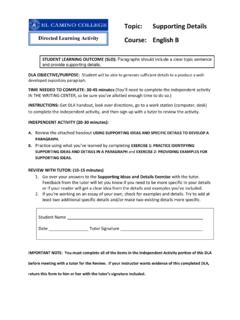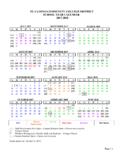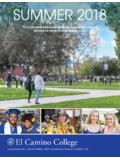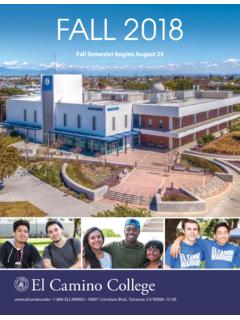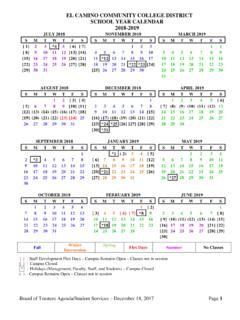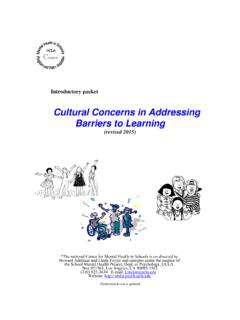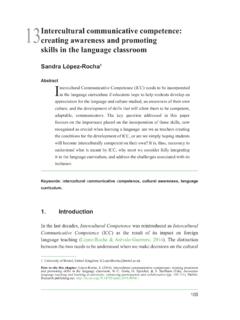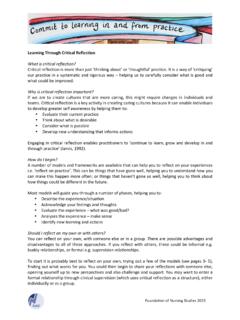Transcription of Fair Assessment Practices: Giving ... - El Camino College
1 Fair Assessment Practices: Giving Students Equitable Opportunties to Demonstrate learning Linda Suskie I am a terrible bowler. On a good night, I break 100. (For those of you who have never bowled, the highest possible score is 300 and a score below 100 is plain awful.) This is a source of great frustration for me. I've taken a bowling class, so I know how I'm supposed to stand and move, hold the ball and release it. Yet despite my best efforts to make my arms and legs move the same way everytime, the ball only rarely rolls where it's supposed to. Why, I wonder, can't my mind make my body perform the way I want it to, every time I roll the ball? If we can't always control our bodily movements, we certainly can't always control what goes on in our heads.
2 Sometimes we write and speak brilliantly; sometimes we're at a loss for words. Sometimes we have great ideas; sometimes we seem in a mental rut. Is it any wonder, then, that Assessment finding out what our students have learned is such a challenge? Because of fluctuations in what's going on inside our heads, we inconsistently and imperfectly tell our students what we want them to do. Because of similar fluctuations in what's going on in our students' heads, coupled with cultural differences and the challenges of interpersonal communication, they can't always fully interpret what we've told them as we intended them to, and they can't always accurately communicate to us what they know. We receive their work, but because of the same factors, we can't always interpret accurately what they've given us.
3 A colleague who's a chemist throws up his hands at all this. Having obtained controlled results in a laboratory, he finds Assessment so full of imprecision that, he says, we can never have confidence in our findings. But to me this is what makes Assessment so fascinating. The answers aren't there in black and white; we have, instead, a puzzle. We gather clues here and there, and from them try to infer an answer to one of the most important questions that educators face: What have our students truly learned? Seven Steps to Fair Assessment If we are to draw reasonably good conclusions about what our students have learned, it is imperative that we make our assessments and our uses of the results as fair as possible for as many students as possible.
4 A fair Assessment is one in which students are given equitable opportunities to demonstrate what they know (Lam, 1995). Does this mean that all students should be treated exactly the same? No! Equitable Assessment means that students are assessed using methods and procedures most appropriate to them. These may vary from one student to the next, depending on the student's prior knowledge, cultural experience, and cognitive style. creating custom-tailored assessments for each student is, of course, largely impractical, but nevertheless there are steps we can take to make our Assessment methods as fair as possible. 1. Have clearly stated learning outcomes and share them with your students, so they know what you expect from them. Help them understand what your most important goals are.
5 Give them a list of the concepts and skills to be covered on the midterm and the rubric you will use to assess their research project. 2. Match your Assessment to what you teach and vice versa. If you expect your students to demonstrate good writing skills, don't assume that they've entered your course or program with those skills already developed. Explain how you define good writing, and help students develop their skills. 3. Use many different measures and many different kinds of measures. One of the most troubling trends in education today is the increased use of a high-stakes Assessment often a standardized multiple-choice test as the sole or primary factor in a significant decision, such as passing a course, graduating, or becoming certified.
6 Given all we know about the inaccuracies of any Assessment , how can we say with confidence that someone scoring, say, a 90 is competent and someone scoring an 89 is not? An Assessment score should not dictate decisions to us; we should make them, based on our professional judgement as educators, after taking into consideration information from a broad variety of assessments. Using "many different measures" doesn't mean Giving your students eight multiple-choice tests instead of just a midterm and final. We know now that students learn and demonstrate their learning in many different ways. Some learn best by reading and writing, others through collaboration with peers, others through listening, creating a schema or design, or hands-on practice.
7 There is evidence that learning styles may vary by culture (McIntyre, 1996), as different ways of thinking are valued in different cultures (Gonzalez, 1996). Because all assessments favor some learning styles over others, it's important to give students a variety of ways to demonstrate what they've learned. 4. Help students learn how to do the Assessment task. My assignments for student projects can run three single-spaced pages, and I also distribute copies of good projects from past classes. This may seem like overkill, but the quality of my students' work is far higher than when I provided less support. Students with poor test-taking skills may need your help in preparing for a high-stakes examination; low achievers and those from disadvantaged backgrounds are particularly likely to benefit (Scruggs & Mastropieri, 1995).
8 Performance-based assessments are not necessarily more equitable than tests; disadvantaged students are likely to have been taught through rote memorization, drill, and practice (Badger, 1999). Computer-based assessments, meanwhile, penalize students from schools without an adequate technology infrastructure (Russell & Haney, 2000). The lesson is clear: No matter what kind of Assessment you are planning, at least some of your students will need your help in learning the skills needed to succeed. 5. Engage and encourage your students. The performance of "field-dependent" students, those who tend to think more holistically than analytically, is greatly influenced by faculty expressions of confidence in their ability (Anderson, 1988). Positive contact with faculty may help students of non-European cultures, in particular, achieve their full potential (Fleming, 1998).
9 6. Interpret Assessment results appropriately. There are several approaches to interpreting Assessment results; choose those most appropriate for the decision you will be making. One common approach is to compare students against their peers. While this may be an appropriate frame of reference for choosing students for a football team or an honor society, there's often little justification for, say, denying an A to a student solely because 11 percent of the class did better. Often it's more appropriate to base a judgement on a standard: Did the student present compelling evidence? summarize accurately? make justifiable inferences? This standards-based approach is particularly appropriate when the student must meet certain criteria in order to progress to the next course or be certified.
10 If the course or program is for enrichment and not part of a sequence, it may be appropriate to consider growth as well. Does the student who once hated medieval art now love it, even though she can't always remember names and dates? Does another student, once incapable of writing a coherent argument, now do so passably, even if his performance is not yet up to your usual standards? 7. Evaluate the outcomes of your assessments. If your students don't do well on a particular Assessment , ask them why. Sometimes your question or prompt isn't clear; sometimes you may find that you simply didn't teach a concept well. Revise your Assessment tools, your pedagogy, or both, and your assessments are bound to be fairer the next time that you use them. Spreading the Word Much of this thinking has been with us for decades, yet it is still not being implemented by many faculty and administrators at many institutions.

